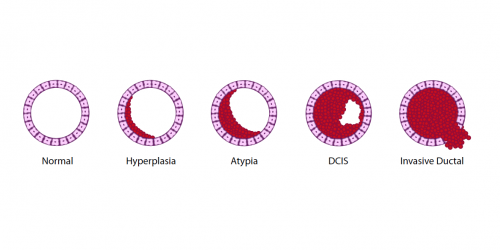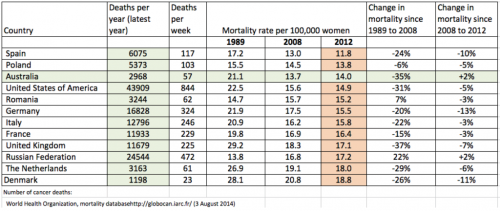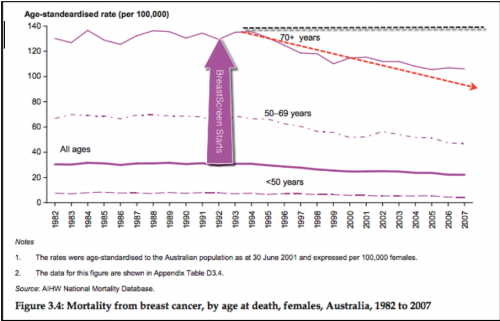Figure 1: Cross-section of a breast duct showing progression from DCIS to invasive breast cancer Credit: Boyages: DCIS of the Breast: Taking Control
Variations in the treatment of DCIS (Ductal Carcinoma In Situ or precancerous cells of the breast) may be a contributing factor in worldwide differences in breast cancer mortality rates according to Professor John Boyages, Director of the Macquarie University Cancer Institute (Figure 1).
The latest statistics from the World Health Organisation show that Australia is still one of the best in the world at reducing the risk of dying from breast cancer. However, although breast cancer mortality rates in Australia fell by a staggering 35% from 1989 until 2008 there has been no real change in the latest statistics published in December 2013 (Figure 2).
In a new book released today DCIS of the Breast: Taking Control by Professor Boyages, he summarises evidence and explains why he believes that if DCIS is left untreated, that for many patients, invasive cancer will occur given enough time.
DCIS means that abnormal cells are lodged in one or more of the breast ducts but they haven't yet escaped to become potentially lethal breast cancer. Professor Boyages calls this "precancer" and often explains this as a pipe that is very strong on the outside but contains some rust on the inside that has not yet penetrated the surface of the pipe. Will the rust break through the pipe? Maybe, maybe not.
However, Professor Boyages says, "If you do not effectively diagnose and treat DCIS, there is no doubt in my mind, that for many patients, invasive breast cancer will occur given enough time.
It is therefore vital for patients diagnosed with DCIS through mammography to understand their own risk, however low, of DCIS returning and the chance of it coming back as invasive breast cancer that may require more intensive treatments such as chemotherapy."
There is no doubt about it – treating DCIS is controversial due to the diversity of medical opinion.
Figure 2: Selected mortality rates sorted by Mortality rates (2012) Date released December 2013
About 40 women every day are diagnosed with breast cancer in Australia and an additional four with DCIS. Professor John Boyages, MD, PhD is a radiation oncologist and has over 30 years' experience and is one the world's all-round experts about this complex disease.
In one study he quotes, 11 of the 29 patients (38%) who did not have treatment of supposedly indolent low-grade DCIS, progressed to invasive cancer over a 30-year time period and six of the 11 died from it. In a virtually unnoticed European clinical trial from September 2013, patients with DCIS treated by a lumpectomy had a 31% recurrence in the breast within 15 years after surgery alone and half (15%) of the recurrences were invasive. Of concern, by 20 years, four of every 10 patients with an invasive breast cancer recurrence had died from it.
"In my opinion, many of these deaths could have been prevented" said Professor Boyages. There is a lot of misinformation out there about DCIS. Epidemiologists say it is over diagnosed and over-treated. On the other hand, treatment to the breast (lumpectomy, lumpectomy and radiation, mastectomy), lymph nodes (sample or not) and medications (tamoxifen or not) also varies widely.
Figure 3: Early detection of DCIS and cancer for women in their 50′s reduces mortality for women in the 70′s dashed black line expected; red dash line- observed.
The detection of DCIS and small cancers for women in their 50's and 60's since BreastScreen started in1992 has led to significantly reduced breast cancer incidence and mortality (Figure 3) for women in their 70's from 1994.
Breast screening works by stopping DCIS progressing to invasive breast cancer years later, and finding small, easier to treat, cancers which have not yet spread. However it is also important to effectively treat detected DCIS to reduce future invasive breast cancer.
Professor Boyages first started treating patients as a specialist oncologist in the late 80's just before coordinated screening programs started in many countries. He said one of the really important initiatives has been the BreastScreen program. Breast screening has acted as a catalyst for doctors to work together in teams, find cancer early and strive to treat it without more difficult treatments such as mastectomy and intensive chemotherapy. However, there is still a lot of variation as to how DCIS is diagnosed and treated based on his large numbers of second opinions he gives for patients with this disease.
It's vital that women have as much information as possible to ensure they get the best conventional treatment but also knowing what they can do for themselves. DCIS of the Breast Taking Control is a 280 page full-colour book and is a must-read. It is a totally comprehensive guide for all patients with DCIS and their caregivers. It addresses finding the right treatment, common side-effects, newer oncoplastic techniques, the role of sentinel node biopsy and tamoxifen and how to cope with life after diagnosis or if DCIS does recur.
Provided by Macquarie University






















